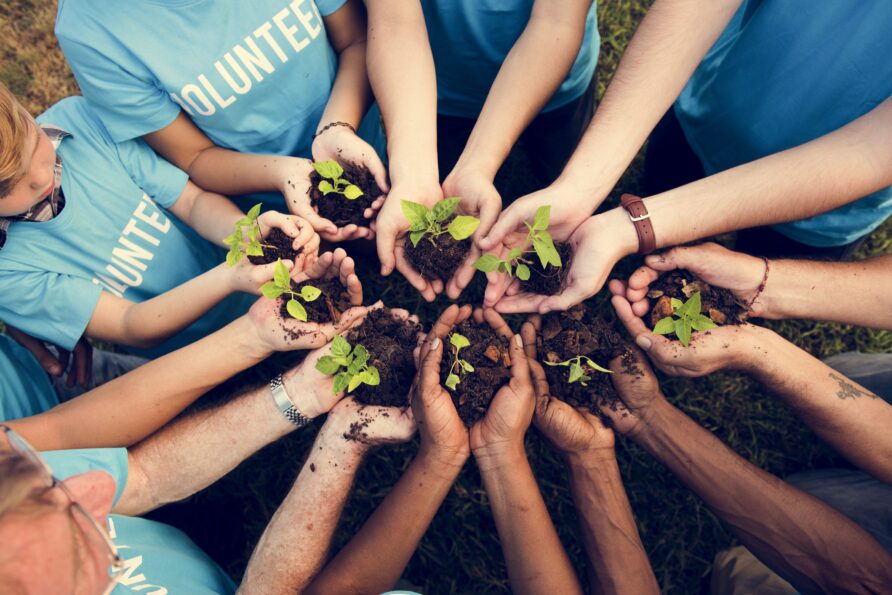
America the Generous: Leading the World in Charitable Giving – What Are We Missing?
The number of people setting up Facebook and TikTok fundraising campaigns instead of asking for birthday gifts is rapidly increasing. While some might roll their eyes at the public display of giving, this trend is far from the worst. It actually raises awareness for social issues and makes them accessible to a wide audience.
The significance of generosity and civil society is a constant across all communities and countries worldwide.
The generous giving behavior of the USA is particularly noticeable. For example, the Bill & Melinda Gates Foundation has spent more than 22 billion dollars on medical research and development projects in recent years.
According to the World Giving Index by the Charities Aid Foundation, which surveyed 1.3 million people in 125 countries, America was one of the most generous countries in the world over the past decade (Pandey, 2022) and currently ranks 5th globally. They don’t only donate; 76% of Americans also help strangers, and 38% engage in volunteer work (Charities Aid Foundation, 2023, p. 7).
The World Giving Index reflects the altruistic commitment of different nations, focusing on three aspects: the willingness to help strangers, monetary donations, and time spent in nonprofit organizations. It is based on data from the World Poll, an ongoing global research project by the Gallup polling firm.
Europe Lags Behind
Not a single European country is in the top 20, and Germany is even listed only at 45th place. The likelihood of Americans engaging in volunteer work is 15% higher than in the Netherlands, 21% higher than in Switzerland, and 32% higher than in Germany (Dreyfus, 2018).
Studies suggest that voluntary engagement not only supports the impact of organizations in the communities they serve. It also connects people with each other and the issues their community faces. It has the power to unite people of different races, ages, religions, and genders for a common cause (Dreyfus, 2018). So, what are we doing wrong in Europe? Are we not generous enough? The question arises whether we should look up to leading countries like the USA and see them as a model for dedicating more time and resources to charitable causes.
To answer this question, it’s important to first examine the reasons for this discrepancy and consider the influence of historical and cultural factors. The importance of volunteering is deeply rooted in American culture, and it even goes back to the founding of the USA. In 1736, Benjamin Franklin founded the first volunteer fire department. In the 1800s, the emerging social reform movement, with issues like poverty, temperance, women’s rights, and the abolition of slavery, mobilized a new generation that had previously not participated in civic life, including women and young people. This led to the founding of the YMCA, the Salvation Army, the American Red Cross, and United Way – institutions that were established to connect volunteer forces with social services with the aim of improving the lives of other people (Dreyfus, 2018).
Moreover, various government initiatives in the 20th century promoted volunteer engagement. Programs like AmeriCorps, established in 1993 under President Bill Clinton, are federal programs that promote domestic volunteer services and offer young adults the opportunity to engage in various areas of the non-profit sector, from education and environmental protection to disaster relief and poverty reduction. These factors together have led to a long tradition of volunteer service in the USA, which continues to this day.
Volunteering in the USA is often seen as a way to contribute to society, solve social problems, and improve the quality of life in communities and, thus, an important part of democracy
Community Service and Service Learning as Educational Goals
This view is already taught in schools with methods like Community Service or Service Learning, which young Americans engage in during their school years. Furco defines Community Service as the “engagement of students in activities that primarily focus on the service being provided as well as the benefits the service activities have on the recipients […].” (Furco, 1996, p. 4). Service Learning combines the service component with school content. Students should take an active influence on society through a variety of activities, from work in soup kitchens to engagement in animal welfare and wildlife projects to support disadvantaged people in surrounding communities or neighborhoods and experience community not just as a theoretical concept but as a lived reality.
The inclusion of Community Service or Service Learning in the curriculum is widespread in the USA. A study by the National Center for Education Statistics found that about a third of public schools in the USA have integrated service learning in some form into their curriculum (Skinner & Chapman, 1999, p. 12).
Thus, students already grow up with the awareness of committing to their community, whether through school projects, church activities, or in the family environment. They learn that their personal commitment hasn’t only a positive impact on their surroundings but is also an integral part of democratic life and civil society. The political education in Germany focuses more on promoting an understanding of democracy and critical thinking and wants to empower students for this. Consequently, active participation doesn’t have the main focus like in the US.
Besides that, the establishment of Service Learning and Community Service in the USA dates back to the 1960s, while this approach only gained popularity in Germany 40 years later and is still not widely spread in schools today (Backhaus-Maul & Jahr, 2021, p. 289). There is still a lack of a sustainable and infrastructural culture of sound collaboration with external partnerships such as communities, museums, or sports clubs (Sliwka, 2004, p. 15).
Volunteering as a Lifeline?
However, the large role of voluntary engagement in the U.S. also has to be seen in relation to political and social structures. In this way, it can be interpreted as a response to a less comprehensive social safety net. The high number of volunteers working in places like soup kitchens or engaging in educational inequalities are often necessary to reach basic social needs that would be unmet due to a lack of state support. Especially in areas like healthcare, social assistance, and public education, there are significant deficits in the U.S. compared to Germany or Europe.
European social systems are more aimed at protecting the poor and providing social security for a broader cross-section of society.
Social programs such as healthcare, unemployment support, and retirement systems are established to cover a wide range of social needs, particularly supporting disadvantaged and needy groups of people. The European “welfare state” is historically shaped because of the extensive, interconnected social policy measures. It reflects European historical experiences with social misery, unrest, protests, political conflicts and wars on one side and reconciliation, cooperation, stability, order, harmony, and peace on the other (Acemoğlu, 2016, p. 3).
Therefore, the comprehensive social security system reduces the need for volunteer services. While in the U.S., non-profit organizations play a central role in providing basic needs such as food donations or homelessness assistance, in Europe, they rather take on a complementary function.
In the U.S., these organizations and initiatives are essential to compensate for deficits in state services.
Voluntary engagement is necessary to offer basic services and support, while here, it functions in support of state services. Using people’s engagement to fill gaps in basic social services leads to an inappropriate shift of responsibility, where citizens are pushed into the role of social service providers. Focusing too strongly on volunteer work could undermine the role of the welfare state, whose task it is to ensure basic services for all citizens.”
Balancing Volunteering: Navigating Between Community Service and Social Responsibility
There is no question that people who volunteer, help others, or do something good for the community will have positive effects on society. Community building, initiative, and personal responsibility are promoted. These aspects could also have positive effects in Europe, especially in areas where state programs have gaps or where a stronger sense of community is desired. Europe can improve on this and create more possibilities for people to volunteer through state programs, as well as teach people in school the meaning and influence of volunteering through various projects. Programs like the “Freiwilliges Soziales Jahr” should receive more support and attention. In many basic areas, such as education, there are always problems where volunteers can provide additional support.
Overall, there is a global increase in voluntary engagement. In Germany, the proportion of people engaged in voluntary work has risen by 10% in the last 20 years (FWS 2019, p. 10). Especially in areas like environmental protection and migration help, the target group for volunteer work is growing, partly due to the refugee wave of 2016 and movements such as “Fridays for Future”.
Furthermore, digitalization offers new forms of volunteer engagement, such as public relations or website design, which can be conveniently done from home.
Therefore, it is expected that the number of volunteer activities in Germany will continue to rise. Nevertheless, we should be cautious not to overemphasize this approach or reshape our entire system around it. At the same time, the U.S. might consider adopting certain aspects of the European social system, integrating them into its own framework. In the end, by learning from each other, we can combine the best elements of both systems.
Bibliography
- Acemoğlu, D. (2016). The Welfare State in Europe. In The search for Europe. BBVA.
- Backhaus-Maul, H., & Roth, C. (2013). Fazit und Perspektiven der Gesamtstudie. In H. Backhaus-Maul & C. Roth, Service Learning an Hochschulen in Deutschland (S. 129–131). Springer Fachmedien Wiesbaden. https://doi.org/10.1007/978-3-658-00124-7_4
- Bundesministerium für Familie, Senioren, Frauen und Jugend (2019). Freiwilliges Engagement in Deutschland. Zentrale Ergebnisse des Fünften Deutschen Freiwilligensurveys.
- Charities Aid Foundation. (2023). CAF World Giving Index 2023.
- Dreyfus, S. N. (2018). Volunteerism and US Civil Society. https://doi.org/10.48558/S830-0D33
- Furco, A. (1996). Service-Learning: A Balanced Approach to Experiential Education.
- Pandey, E. (2022). America the generous: U.S. leads globe in giving. https://www.axios.com/2022/03/09/america-charitable-giving-stats-ukraine
- Sliwka, A. (2004). Service Learning: Verantwortung lernen in Schule und Gemeinde. 36 pages. https://doi.org/10.25656/01:258
- Skinner, R., & Chapman, C. (1999). Service-Learning and Community Service in K-12 Public Schools.

Jana Moritz
Jana Moritz is pursuing a Masters’s degree in Education (German and Politics) with a long-term goal of working on political education in international organizations. She has had various international experiences, including stays at SDSU in San Diego, California and the Deutsche Schule Albrecht Dürer in Sevilla, Spain. Currently she is doing an internship at the Friedrich Naumann Stiftung in Brussels, focusing on European Affairs.
